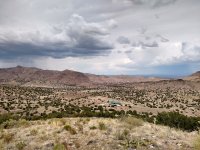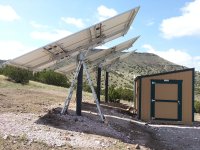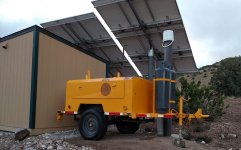pwright
Gold Member
Because I find myself posting bits of this info in other threads somewhat frequently I thought I would post it all together in a hopefully more coherent manner and will just reference this post/thread in the future.
Background
A few years ago we bought some property out in the sticks here in central New Mexico. It's ~16 miles by dirt road to the site and there are no utilities so a well, propane tank and solar was the only way to have a normal house. Nothing too difficult or interesting about putting in a well or propane tank so this is about the solar system.

My wife is an electrical engineer and I am a software developer. We love our gadgets, 24/7 internet access and watching our favorite TV shows on the big screen. This wasn't going to be minimal impact eco house. The goal was that, as best we could, life inside the house would be much like being back in civilization.
Solar Panels
We are using 255 watt panels. There are 27 panels mounted on three poles. Total potential power from the panels is 6.9 kW. The panels are connected as 9 groups of 3 panels in series (~92V @ 8.3A) to feed the charge controllers. Power from solar systems is typcially calculated based on 6 hours of usable sunlight per day. So at winter solstice we get about 41.3 kWh a day. Just a couple years later now and the 300 watt panels are about the same price.
Panel Mounting
This is open grazing land, so we have cows wandering around, and have deer, elk, javelina and other wildlife as well so ground mounting wasn't an option. Mounting them on the roof wasn't really desired as adjusting tilt is more difficult and would require more roof penetrations. As mentioned above the panels are on poles (8" SCH40) which are buried 4' with 1.5 yards of concrete and stand 8' above ground. The DPW mount allows for 15 to 65 degree tilt.

Batteries
For power storage we are using two banks of Surrette AGM 415 aH 6V batteries. Each bank has 8 batteries in series (48 VDC) with the banks in parallel (830 aH). Doing the math this gives us 830 aH @ 48 VDC for 39.8 kWh of total storage. Usable storage is really only half of that as you don't want to be draining your batteries down too far on any regular basis. We can get about a day and half off the batteries without draining them too much.
Inverters/Charge Controllers
We are using dual Magnum Energy 4400 Watt pure sine inverters in parallel to give us 8.8 kW of 240V AC power to the house. Along with the inverters are two Midnite Solar Classic 150 MPPT charge controllers to keep the batteries charged.
Backup Power
We have an older Kohler 7.6C61 water-cooled, four cylinder 7.5 kW generator for backup when the sun goes missing. Wasn't keep track of usage this past winter but I know it ran for 3-4 hours on 4 or 5 days. Ran it again for 4 hours a few days ago when we had heavy overcast and rain for most of the day.

Solar Power Shed
We wanted to minimize the length of the DC current runs so a we had a shed built right under the poles to hold the batteries, inverters and charge controllers. This allowed us to run a normal AC feed to the house panel via a 75' trench and conduit.
House
The 2272 sqft house (plus 922 sqft garage on slab) is a pretty normal stick-built construction on a pier & beam foundation. The exterior walls are 2x6 and we used R21 denim insulation in the walls. Metal roof and stucco exterior.
The house was wired like a normal on-grid house. We are using CFL or LED lighting of course. Appliances were chosen for efficiency but are still typical consumer items. Refrigerator, microwave, dishwasher, washer and small chest freezer are electric. Stove, dryer and Rheem on-demand water heater all run off propane.
Heating/Cooling
This is the southwest so evaporative coolers are the norm and we are using a MasterCool ASA7112 cooler with a 1 hp blower motor. For heat we have a Bryant Plus 80 furnace running on propane plus a Harmon P61A pellet stove. The pellet stove is in our primary living space and is our heat in the evenings and when there is no sunlight. The furnace is used to get the whole house warmed up on cold mornings or during the day when there is surplus solar power.
Power Usage
The main power drains are the refrigerator and freezer as they are on all the time. During summer and winter the heater and cooler motors are the big draws as they are running quite a bit. Each one uses about 800 watts while running. Fortunately the times we need to run the cooler the most is also when we have the most sun. Much of the time it is running off of surplus power. Which is to say the panels are producing more power than is needed to charge the batteries and run the house.
On a typical day the batteries are fully charged by 1PM or sooner. By 8AM or so the house is running entirely off of surplus power not needed for charging the batteries.
Lessons Learned & Living Solar
Don't forget the little power drains. While we had factored in our multiple computers, networking gear and other odd electric devices we hadn't accounted for the DirectTV receiver/DVR nor the Hughesnet satellite modem. Both run 24/7 and at 50 watts each use 2.4 kWh a day. We had included quite a bit of wiggle room in our power budget so it wasn't an issue but we had fun running around with the kill-o-watt meter figuring out what was drawing that power.
Not so much a lesson learned but a change to our previous behavior of running things whenever we wanted is that we do all our laundry during the day. Same with the dishwasher and well pump.
Because we are paranoid we also bought line conditioners (not just surge protectors but actual conditioners) to run our computers off of as the power can fluctuate a bit when the second invertor kicks in or a big load like turns on/off. Haven't had any actual issues with anything but better safe than sorry.
We've thought about adding a third battery bank but the cost of a battery bank would pay for years of fuel for the generator so it doesn't really make sense to do that from a cost perspective.
The panels were mounted and everything hooked up in the power shed in Oct of 2014. Power was hooked up to the house in March of 2015. We've been living in it full time since May of 2015. Never given us a moment of grief so far.
Background
A few years ago we bought some property out in the sticks here in central New Mexico. It's ~16 miles by dirt road to the site and there are no utilities so a well, propane tank and solar was the only way to have a normal house. Nothing too difficult or interesting about putting in a well or propane tank so this is about the solar system.

My wife is an electrical engineer and I am a software developer. We love our gadgets, 24/7 internet access and watching our favorite TV shows on the big screen. This wasn't going to be minimal impact eco house. The goal was that, as best we could, life inside the house would be much like being back in civilization.
Solar Panels
We are using 255 watt panels. There are 27 panels mounted on three poles. Total potential power from the panels is 6.9 kW. The panels are connected as 9 groups of 3 panels in series (~92V @ 8.3A) to feed the charge controllers. Power from solar systems is typcially calculated based on 6 hours of usable sunlight per day. So at winter solstice we get about 41.3 kWh a day. Just a couple years later now and the 300 watt panels are about the same price.
Panel Mounting
This is open grazing land, so we have cows wandering around, and have deer, elk, javelina and other wildlife as well so ground mounting wasn't an option. Mounting them on the roof wasn't really desired as adjusting tilt is more difficult and would require more roof penetrations. As mentioned above the panels are on poles (8" SCH40) which are buried 4' with 1.5 yards of concrete and stand 8' above ground. The DPW mount allows for 15 to 65 degree tilt.

Batteries
For power storage we are using two banks of Surrette AGM 415 aH 6V batteries. Each bank has 8 batteries in series (48 VDC) with the banks in parallel (830 aH). Doing the math this gives us 830 aH @ 48 VDC for 39.8 kWh of total storage. Usable storage is really only half of that as you don't want to be draining your batteries down too far on any regular basis. We can get about a day and half off the batteries without draining them too much.
Inverters/Charge Controllers
We are using dual Magnum Energy 4400 Watt pure sine inverters in parallel to give us 8.8 kW of 240V AC power to the house. Along with the inverters are two Midnite Solar Classic 150 MPPT charge controllers to keep the batteries charged.
Backup Power
We have an older Kohler 7.6C61 water-cooled, four cylinder 7.5 kW generator for backup when the sun goes missing. Wasn't keep track of usage this past winter but I know it ran for 3-4 hours on 4 or 5 days. Ran it again for 4 hours a few days ago when we had heavy overcast and rain for most of the day.

Solar Power Shed
We wanted to minimize the length of the DC current runs so a we had a shed built right under the poles to hold the batteries, inverters and charge controllers. This allowed us to run a normal AC feed to the house panel via a 75' trench and conduit.
House
The 2272 sqft house (plus 922 sqft garage on slab) is a pretty normal stick-built construction on a pier & beam foundation. The exterior walls are 2x6 and we used R21 denim insulation in the walls. Metal roof and stucco exterior.
The house was wired like a normal on-grid house. We are using CFL or LED lighting of course. Appliances were chosen for efficiency but are still typical consumer items. Refrigerator, microwave, dishwasher, washer and small chest freezer are electric. Stove, dryer and Rheem on-demand water heater all run off propane.
Heating/Cooling
This is the southwest so evaporative coolers are the norm and we are using a MasterCool ASA7112 cooler with a 1 hp blower motor. For heat we have a Bryant Plus 80 furnace running on propane plus a Harmon P61A pellet stove. The pellet stove is in our primary living space and is our heat in the evenings and when there is no sunlight. The furnace is used to get the whole house warmed up on cold mornings or during the day when there is surplus solar power.
Power Usage
The main power drains are the refrigerator and freezer as they are on all the time. During summer and winter the heater and cooler motors are the big draws as they are running quite a bit. Each one uses about 800 watts while running. Fortunately the times we need to run the cooler the most is also when we have the most sun. Much of the time it is running off of surplus power. Which is to say the panels are producing more power than is needed to charge the batteries and run the house.
On a typical day the batteries are fully charged by 1PM or sooner. By 8AM or so the house is running entirely off of surplus power not needed for charging the batteries.
Lessons Learned & Living Solar
Don't forget the little power drains. While we had factored in our multiple computers, networking gear and other odd electric devices we hadn't accounted for the DirectTV receiver/DVR nor the Hughesnet satellite modem. Both run 24/7 and at 50 watts each use 2.4 kWh a day. We had included quite a bit of wiggle room in our power budget so it wasn't an issue but we had fun running around with the kill-o-watt meter figuring out what was drawing that power.
Not so much a lesson learned but a change to our previous behavior of running things whenever we wanted is that we do all our laundry during the day. Same with the dishwasher and well pump.
Because we are paranoid we also bought line conditioners (not just surge protectors but actual conditioners) to run our computers off of as the power can fluctuate a bit when the second invertor kicks in or a big load like turns on/off. Haven't had any actual issues with anything but better safe than sorry.
We've thought about adding a third battery bank but the cost of a battery bank would pay for years of fuel for the generator so it doesn't really make sense to do that from a cost perspective.
The panels were mounted and everything hooked up in the power shed in Oct of 2014. Power was hooked up to the house in March of 2015. We've been living in it full time since May of 2015. Never given us a moment of grief so far.